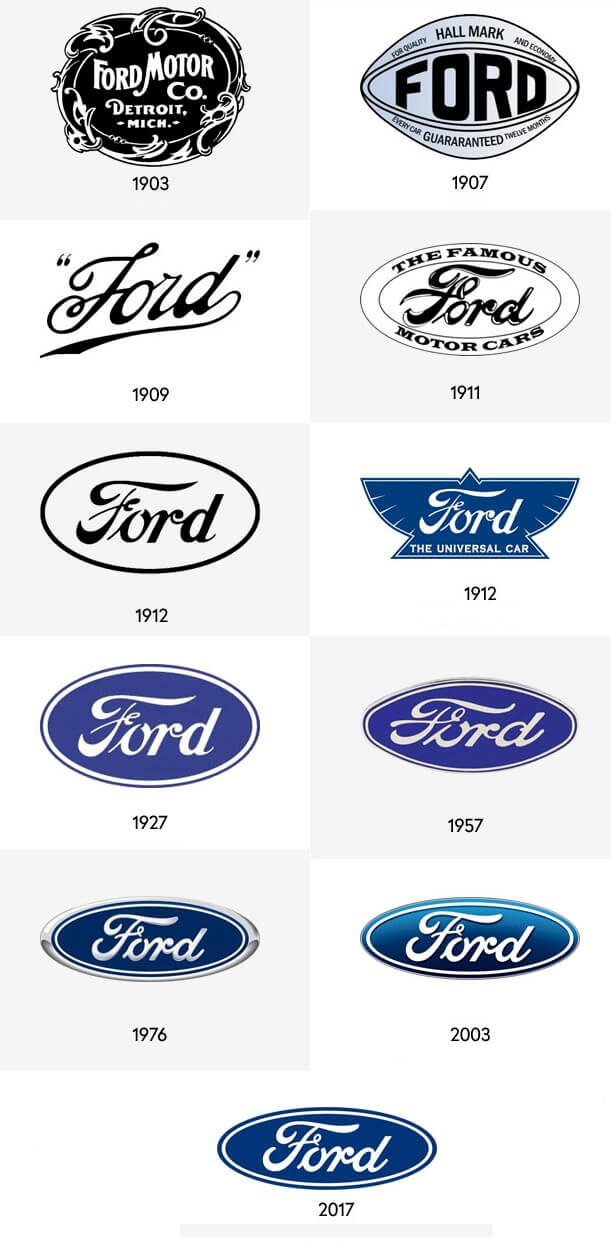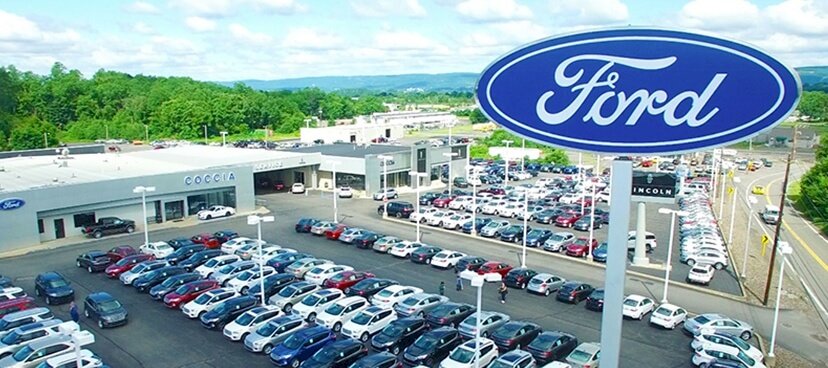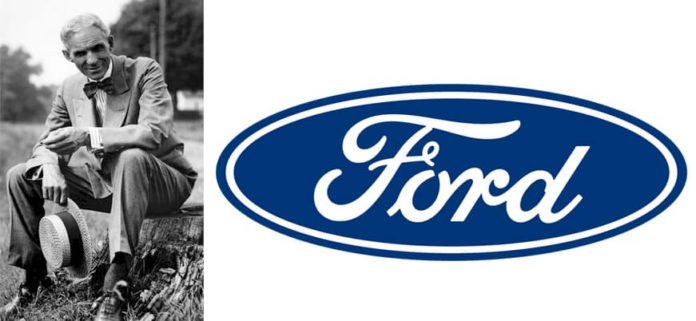This is a look at the Ford logo and the history of the auto maker.
Ford is one of the most recognizable brands in the motor vehicle manufacturing industry and boasts one of the world’s most famous logos. And like the company itself, the logo is full of meaning and history. In the paragraphs below, we’ll take a peek at the history of the Ford logo, its evolution, its design elements, and then go over the history of the Ford Motor Company.
The History of the Ford Logo
When the Ford Motor Company was founded in 1903 by Henry Ford, the logo was so far removed from the blue ford emblem customers see today. It was, in fact, green and wasn’t rendered in the distinctive text you see today.
Indeed, the first Ford emblem was far more intricate, with a combination of extra text and an embroidered edge.
While the company didn’t display the iconic Ford inscription on its first-ever Ford Model A, Ford commonly used it in all company correspondence. Apart from the famous tale that the Ford logo is Henry Ford’s signature, it was designed by Childe Harold Willis, the company’s first chief engineer and designer.
The Ford inscription first appeared on the famous Ford logo in 1907. From that point on, it has been included in every Ford logo version, but the text has gone through minor changes.
Twenty-four years after Ford’s inception, the company altered its emblem to a design similar to the one it uses today. While the brand has had three official logo versions since 1927, they are all very similar to the current version.
They all have undergone minor changes, such as making minor alterations to the Ford inscription and making the oval a little rounder.
The Ford Logo Evolution

Ford’s oval emblem is one of the most famous corporate symbols the world over and has been consistently used for over half a century. The inscription emblem traced its origins to Ford’s start when Henry Ford’s assistant engineer came up with a stylized variant of the phrase “Ford Motor Company.”
1903: Logos and Letters
Ford first used the Ford inscription on company correspondence in 1903. However, the first car produced (the Ford Model A) got special treatment. Ford designed the car’s first logo, complete with a very fashionable art nouveau border.
1906: Winged Script
In 1906, a more advanced form of the Ford inscription came out with long-tailed letters “F” and “D” and was dubbed the “winged script.”
This Ford logo design was plastered on all Ford models up to 1910 when the inscription was again revised to the version that’s still being used to date. In 1909, the Ford inscription emblem was patented in the United States.
1907: First Oval
In 1907, British agents Perry, Schreiber, and Thornton introduced the Ford oval emblem. They were the precursors to the first Ford Motor Company in the UK. This oval advertised Ford as the “epitome of reliability and economy.”
1911: Distinctive Oval
Ford designed the distinctive oval logo by combining an oval with the Ford inscription in 1911. The company used this design to identify dealerships in Great Britain mainly. But the Ford cars and correspondence kept using the Ford inscription until the end of the 1920s.
1912: Universal Car
Ford briefly ditched the oval emblem and replaced it with a winged triangle emblem. Originally created to symbolize lightness, speed, stability, and grace, the Ford logo design was dark blue or orange and bore the phrase “The Universal Car.” The founder disliked the logo, and it was swiftly jettisoned.
1927: Oval Badge
In 1927, the new Ford Model A became the first Ford car to feature the oval as a radiator emblem. With the famous deep royal blue backdrop that you know today, many vehicles spotted the logo until the late 1950s. While used regularly on company correspondence, the oval emblem wasn’t used on Ford cars again until 1976.
1976-Present: Blue Oval
Since 1979, all Ford vehicles have been identified by the silver and deep royal blue oval. This has provided easily recognizable and reliable branding for all of Ford’s products, facilities, and plants worldwide.
The Ford Logo Design Elements

Ford Emblem: The Ford emblem is a flat oval shape designed in several hues of white and blue. The oval includes the famous and classy Henry Ford signature. The Ford Motor Company has always reiterated the importance of recognition, tradition, and style and has only made minor alterations to the logo throughout its long, successful history.
Ford Logo Font: The famous Ford inscription is rendered in a custom font, which is very similar to the Ford script font, as well as the sleek and stylish Neville Regular and Fabiola Script. It’s believed that the inscription was inspired by the signature of Henry Ford.
Ford Logo Color: The Ford logo design has long been synonymous with the deep royal blue shade, which has made it world-famous. The latest Ford logo design, introduced to celebrate Ford’s centenary in 2003, features various shades of blue, including sky blue and navy blue. The Ford inscription is rendered in white, and there’s also an oval line in white embedded into the design. At the beginning of the Ford empire, the logo was black and white.
The History of Ford Motor Company

Ford Motor Company, simply known as Ford, is an American automotive company that Henry Ford founded along with 11 associate investors in 1903. The firm was reincorporated in 1919, with Henry Ford’s family acquiring total ownership.
The sole shareholders were Henry Ford, his wife, his son, their heirs, as well as the Ford Foundation until 1956, when the common shares were first offered to the public. The automaker is headquartered in Dearborn, Michigan, and makes passenger cars, tractors, trucks, as well as motor vehicle parts and accessories.
Early History
Henry Ford made his first trial car in 1896 in Detroit, Michigan. After the Ford Motor Company was formed in 1903, the first car was assembled in July of that year. Five years later, the highly successful Ford Model T was unveiled. This car was in such great demand that Ford came up with new mass-production methods to make sufficient quantities of it.
In 1911, Henry Ford established Ford’s first American branch assembly factory in Kansas City and launched Ford’s first production plant overseas in Manchester, England. Two years later, Henry Ford introduced the first moving assembly range in the world. And in 1914, in order to increase labor productivity further, he introduced a daily wage of $5 for an 8-hour workday (in place of $2.34 for a 9-hour workday).
In 1908, Ford opened its first overseas sales branch in Paris. By mid-1914, all of the world’s roads had over 500,000 Ford Model T cars. By 1923, Ford was producing over half of all automobiles in the U.S. By the late 1920s. The company had over 20 overseas assembly factories in South America, Europe, Canada, Asia, Australia, and South Africa.
The Ford became the most popular car make in the world. In 1927, the first new Ford Model A and the last Model T were manufactured, followed by the first V-8 in 1932.
In 1922, Ford bought the Lincoln Motor Corporation (established in 1917) to manufacture Ford’s first luxury Continentals and Lincolns. In 1938, Ford unveiled the first Mercury, a medium-priced car.
Restructuring and Expansion
By 1906, Henry Ford owned 58.5% of Ford. When the other shareholders railed against the idea of constructing the expensive and giant River Rouge production plant in Dearborn, Detroit, Henry bought them out. In 1909, his son Edsel Ford became president.
In 1943, Edsel passed away, and Henry Ford resumed the presidency. Two years later, Henry Ford II (his grandson) took over as president and restructured the company’s jumbled financial management system. He also improved the company’s culture by recruiting talented youthful executives. The unsuccessful implementation of the Edsel blueprint occurred amid these triumphs. Henry Ford II served as the company’s CEO from 1945 to 1970 and chaired the board from 1960 to 1980.
Throughout the 1950s and 1960s, Ford began diversification but on a limited scale. By the 1990s, however, the company had shifted its focus to automobile matters and financial services. The company acquired Jaguar (a UK luxury car manufacturer) in 1989.
By 1993, Aston Martin had become a fully owned subsidiary. Later buyouts included the 1994 acquisition of the rental car firm Hertz Corporation, the 1999 buyout of Volvo’s automobile division, and the 2000 buyout of the Land Rover SUVs.
Ford also bought a substantial stake in Mazda. But as Ford’s fortunes dwindled in the early 2000s, it started selling these brands off. Hertz was sold in 2005, and Aston Martin was sold in 2007. In 2008, Ford sold Land Rover and Jaguar to India’s Tata Motors Ltd. In 2008, Ford began selling its Mazda stocks and divested completely in 2015.
Ford Today

It was December, 2008 when President George W. Bush announced that the “Big Three” car makers Ford, General Motors Corporation, and Chrysler LLC would receive an emergency financial bailout package to prevent the demise of the country’s ailing automobile industry.
The loans would help the automobile manufacturers stay operational until March 2009 at least, when they were to prove their “financial sustainability” or return the funds. An extra stipulation required the firms to undergo reorganization. The money was made available to Chrysler and General Motors first—Ford allegedly had enough money to stay afloat and therefore didn’t immediately need government assistance.
Ford was able to escape bankruptcy—which both Chrysler and General Motors filed for—and experience increased market share and sales in 2009. The success was in part due to the “cash-for-clunkers” plan by the federal government, which gave customers up to $4,500 to help them trade in older vehicles for brand new fuel-efficient models.
Moreover, Ford focused on stronger vehicle brands and implemented a variety of cost-cutting measures. In 2010, Ford sold Volvo to Zhejiang Geely Holding, a Chinese company. Months later, Ford revealed that it’d stop producing its Mercury range of cars.
But as sales flagged, the carmaker sought to expand its offerings. In 2016, Ford came up with Ford Smart Mobility to produce self-driving vehicles and car-sharing ventures, among other initiatives. A year later, Ford announced plans to increase its range of electric cars.
But in 2018, the company started phasing out all its passenger cars, save for the Ford Focus Active and Mustang. Instead, the carmaker was going to shift its attention to sports utility vehicles, crossover vehicles, and pickups.
Key Timelines
1903: Ford Motor Company is incorporated by Henry Ford along with 11 other investors.
1908: Ford unveils the Ford Model T, which quickly becomes one of the world’s most popular cars. Production was officially halted in 1927 after more than 15 million cars had been made worldwide.
1913: The world’s first moving car assembly line, The Highland Park, starts operations in Michigan.
1914: Ford starts offering $5 a day for 8-hour workdays, replacing the previous wage of $2.34 a day for 9-hour workdays.
1941: Ford starts to manufacture multipurpose “Jeeps” for the United States Army and focuses completely on army vehicles in 1942. Civilian vehicle production only resumes in 1945.
1956: Ford sells its common stock. 10.2 million shares are sold on day one, representing 22% of the firm.
1987: Ford buys 75% of British car brand Aston Martin.
1989: Ford buys Jaguar cars for $2.5 billion.
1990: Ford unveils the Explorer SUV. While this was America’s best-selling SUV car, sales dipped by 29%, a 15-year low.
1992: Ford acquires 50% of Mazda and renames the company AutoAlliance Limited.
1993: The first Ford dealerships in China are opened. Ford sales in China rose by 46% in 2005, though they still lagged behind those of General Motors Corporation and Germany’s Volkswagen.
2005: Ford puts the Mercury Mariner, its new gas-electric hybrid sports utility vehicle, on sale. Compared to the gas-only version, it costs an extra $4,000.
2005: For the 10th successive year, Ford’s market share shrinks, and the company is also replaced by GM’s Chevrolet as America’s best-selling car brand.
Summing Up the History of Ford Motor Company
Ford Motor Company, also commonly known just as Ford, is a United States multinational car manufacturer headquartered in a Detroit suburb, Dearborn. The firm sells commercial and passenger vehicles under the brand Ford and most luxury cars under the brand Lincoln.
Ford also owns Troller, a Brazilian sports utility vehicle manufacturer, 8% of British car brand Aston Martin, and 32% of Jiangling Motors. By 2019, Ford was the largest car manufacturer in the United States and one of the world’s largest. The Ford logo is seen by millions of people all over the world and continues to grow in popularity.







